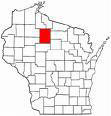

The area was originally
homelands to the Santee Dakota (Sioux) and later to the Anishinabe (Ojibwe).
Between 1842 and 1854, after pushing the Santee Dakota westward, the Ojibwe ceded millions of acres of the land (including the
area of present day
In 1864 the voices of
government surveyors broke the silence in the forests as they began to platte the area. Lumber was in great demand at the time
and by the 1870’s lumber companies had moved into the area. As the land
was stripped of its valuable timber, immigrant settlers began to move into
the area purchasing the cut-over lands that had become tax burdens to the
lumber companies. The first settlements were the Town of
The community of
During the winter of 1883-1884,
surveyors for the Minneapolis, Sault Ste. Marie and Atlantic Railroad plotted
a right-of-way through
As more and more settlers moved into the area, the need for schools and roads increased along with an increase in taxes. Disputes over tax assessments led to changes in the boundaries of the settlements resulting in the formation of new townships.
Swedish, Norwegian and Finnish immigrants
from
Once the land had been depleted of timber, farming became a predominant livelihood along with logging and millwork. Many of the early settlements grew into villages, towns and cities while others disappeared with the lumberjacks.
In 1933, three Civilian Conservation Corps (CCC) camps were established in the county. The men employed in these camps played a big role in the recovery of the land.
Today,
Price
Data from New York Times Immigration Explorer

Civilian Conservation Corps
(CCC Camps)
The Civilian Conservation Corps, more commonly referred to
as the CCC's, was established on 21 March 1933 by
President Franklin D. Roosevelt. It was part of
The CCC soon became one of the
most successful programs of the New Deal due to its popularity among the
general public. The CCC operated in every
The Civilian Conservation Corps was operated by the United
States Department of the Army and sponsored by various other government
departments. The CCC's in
The men who joined the CCC lived in camps (tents and rustic cabins); wore uniforms and followed a quasi-military discipline regime. It was a requirement that they send $25 of their $30 monthly salary back home to their family.
There were several CCC camps scattered throughout the Chequamegon-Nicolet National Forest between 1933 to 1942.
|
Civilian Conservation Corps - |
|
|
Date Established |
Project No. |
Company No. |
Location |
|
|
14 May 1933 |
F-3 |
642 |
Fifield: sixteen (16) miles east of Fifield
on Highway 70. |
|
Sheep Ranch |
19 May 1933 |
F-4 |
644 |
Phillips: Sheep Ranch was
often called " |
|
|
23 Jun 1933
|
S-56
|
1610
|
The camp named |
All three CCC camps in
Copyright © 1996 - The USGenWeb® Project, WIGenWeb, Price County
Design by Templates in Time
This page was last updated 11/06/2024